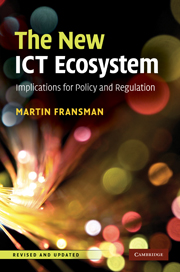Book contents
- Frontmatter
- Contents
- List of exhibits
- Preface
- List of abbreviations and acronyms
- Introduction
- 1 Summary of the argument
- 2 The new ICT ecosystem: architectural structure
- 3 The new ICT ecosystem as an innovation system
- 4 The new ICT ecosystem: a quantitative analysis
- 5 Telecoms regulation
- 6 Policy-making for the new ICT ecosystem
- 7 The way forward: the message to policy-makers and regulators
- Appendixes
- 1 The evolution of the new ICT ecosystem, 1945–2007: how innovation drives the system
- 2 European regulation of electronic communications, 1987–2003
- 3 Some problems with the dominant regulatory paradigm in telecoms (DRPT)
- 4 A short introduction to Schumpeterian evolutionary economics
- 5 Other layer models: OSI and TCP/IP
- 6 Content, applications and services: definitions
- 7 Why do US Internet companies dominate in layer 3?
- 8 How did East Asia (Japan, Korea, Taiwan and China) become so strong in layer 1?
- 9 China's telecoms service providers in layer 2
- 10 Companies in our database, by layer
- Bibliography
- Index
5 - Other layer models: OSI and TCP/IP
Published online by Cambridge University Press: 04 May 2010
- Frontmatter
- Contents
- List of exhibits
- Preface
- List of abbreviations and acronyms
- Introduction
- 1 Summary of the argument
- 2 The new ICT ecosystem: architectural structure
- 3 The new ICT ecosystem as an innovation system
- 4 The new ICT ecosystem: a quantitative analysis
- 5 Telecoms regulation
- 6 Policy-making for the new ICT ecosystem
- 7 The way forward: the message to policy-makers and regulators
- Appendixes
- 1 The evolution of the new ICT ecosystem, 1945–2007: how innovation drives the system
- 2 European regulation of electronic communications, 1987–2003
- 3 Some problems with the dominant regulatory paradigm in telecoms (DRPT)
- 4 A short introduction to Schumpeterian evolutionary economics
- 5 Other layer models: OSI and TCP/IP
- 6 Content, applications and services: definitions
- 7 Why do US Internet companies dominate in layer 3?
- 8 How did East Asia (Japan, Korea, Taiwan and China) become so strong in layer 1?
- 9 China's telecoms service providers in layer 2
- 10 Companies in our database, by layer
- Bibliography
- Index
Summary
In this book a layer model was developed in order to help analyse the ICT ecosystem. In chapter 1 it was shown that the Japanese ministry-regulator (MIC) had used a similar model. In this appendix a very brief summary is provided of two of the best-known layer models that have been used primarily by engineers in the areas of computing and telecommunications.
The Open System Interconnection (OSI) model is a seven-layered description of open (non-proprietary) communications and computer network protocols. It was established in the 1980s by the International Standards Organisation (ISO). The definitive account of this model is provided in ISO (1994). The original intention of the OSI model was to understand the hardware and software that comprised a network. The basic OSI model is shown in exhibit A5.1.
The TCP/IP model deals with the communications protocols that are used to connect hosts in the Internet. These protocols are expressed in a modular set of layers. A description of the part played by TCP/IP in the development of the Internet is provided by Cerf (1989). A recent discussion of the OSI and TCP/IP models is to be found in Mindel and Sicker (2006). The TCP/IP model is shown inexhibit A5.2.
It is worth repeating that the two layer models discussed briefly here deal primarily with technical functionalities and relationships. By contrast, the layer model used in this book to analyse the ICT ecosystem, while also having a technical dimension, is simultaneously about economic and institutional relationships.
- Type
- Chapter
- Information
- The New ICT EcosystemImplications for Policy and Regulation, pp. 168 - 169Publisher: Cambridge University PressPrint publication year: 2010



